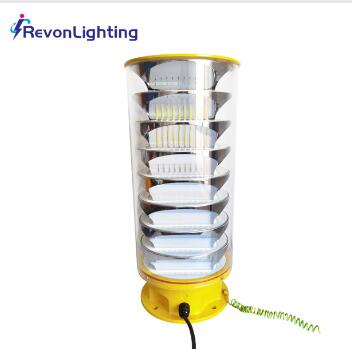Obstruction lights play a crucial role in aviation safety by ensuring the visibility of tall structures and obstacles in the airspace. These lights, also known as aviation obstruction lights, are specifically designed to alert pilots to potential hazards and prevent collisions. In this article, we will explore the importance of obstruction lights in aviation, their types, regulations, and their role in safeguarding the skies.
Importance of Obstruction Lights in Aviation:
Obstruction lights are of paramount importance in aviation safety as they provide a visual cue to pilots, indicating the presence of obstacles in their flight path. These lights are particularly crucial for tall structures such as communication towers, wind turbines, and high-rise buildings. By increasing visibility, obstruction lights help pilots navigate safely and avoid potential hazards.
Types of Obstruction Lights:
Red Obstruction Lights: Red is the most common color used in obstruction lights. These lights emit a steady or flashing red light, depending on regulations and the specific location. Red obstruction lights are typically used on structures taller than a certain height specified by aviation authorities.

Dual Lighting Systems: Some obstruction lights incorporate dual lighting systems, combining steady-burning lights with flashing lights. This combination enhances visibility, especially in areas with high air traffic or challenging weather conditions. The steady-burning lights ensure continuous visibility, while the flashing lights provide additional attention-grabbing signals.
High-Intensity White Lights: In some cases, white lights are used as obstruction lights, particularly for structures near airports or areas with heavy air traffic. These high-intensity white lights, often in the form of strobe lights, provide enhanced visibility even in poor weather conditions.
| 1. Obstruction light aviation | 4. Obstruction light aviation |
| 2. Obstruction lights aviation | 5 |
| 3 | 6 |
Regulations and Standards:
Obstruction lights are subject to regulations and standards set by aviation authorities, such as the International Civil Aviation Organization (ICAO) and the Federal Aviation Administration (FAA). These regulations specify the color, intensity, and placement requirements for obstruction lighting systems. Compliance with these regulations is essential to ensure consistent and effective implementation of obstruction lights.
Maintenance and Inspections:
Regular maintenance and inspections are crucial for the proper functioning of obstruction lights. It is important to ensure that the lights are clean and free from any debris that could obstruct the light output. Routine inspections of the electrical components and bulbs help identify any issues and ensure optimal performance.
Conclusion:
Obstruction lights aviation are vital for aviation safety, providing enhanced visibility and alerting pilots to potential obstacles. Whether using red lights, dual lighting systems, or high-intensity white lights, obstruction lights play a crucial role in preventing accidents and protecting both aircraft and individuals on the ground. Compliance with regulations and regular maintenance are essential to ensure the proper functioning of obstruction lights. As aviation continues to evolve, obstruction lights will remain a critical component in safeguarding the skies and ensuring safe flights for all.